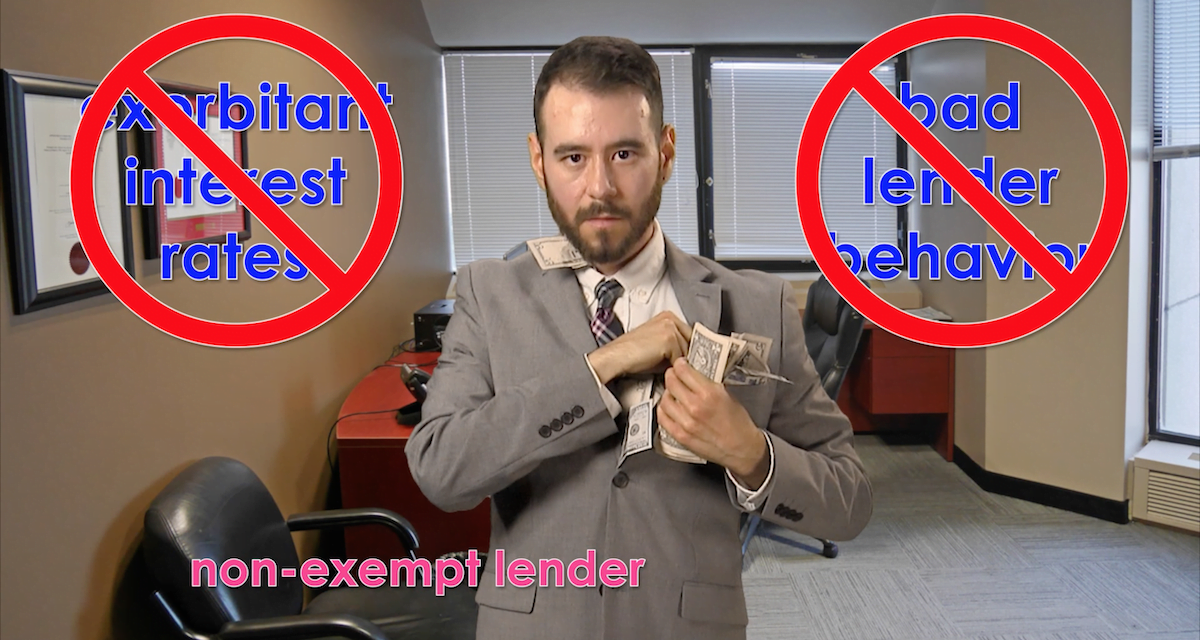What is usury?
When a mortgage is made, the lender charges the borrow interest for the use of the money during the period lent.
However, the amount of interest a private, non-exempt lender can charge is regulated by statute and the California Constitution. Collectively, these are referred to as usury laws. [Calif. Constitution, Article XV; Calif. Civil Code §1916-1 through 1916-5]
Today, the remaining goal of usury laws is the prevention of loan-sharking by private lenders. Loan-sharking is the act of charging interest at a higher rate than the allowable ceiling-rate established by the usury laws. These mortgages are categorized as usurious. [CC §1916.3(b)]
Usury exemptions spur competition
Adopted in 1918 as a consumer protection referendum, the first California usury laws set the maximum interest rate at 12% for all lenders — no exceptions.
During the Great Depression, California legislation exempted certain types of lenders from usury restrictions. The exemptions were implemented with the intent to open up the mortgage market. [Cal. Const. Art. XV]
These exemptions to usury laws remain in place today and more have been added. For example, in 1979, mortgages made or arranged in California by real estate brokers were exempted from usury restrictions.
Other types of lenders exempted from usury law restrictions include:
- savings and loan associations (S&Ls);
- state and national banks;
- industrial mortgage companies;
- credit unions and pawnbrokers;
- agricultural cooperatives;
- corporate insurance companies; and
- personal property brokers. [Cal. Const. Art. VX]
Exemptions successfully opened the market by increasing the availability of funds. In turn, interest rates were soon driven lower due to increased competition.
Interest paid with goods and services
When a borrower pays interest on a mortgage, they are essentially paying rent to the lender for use of its money for a period of time. The money lent is fully repaid during or at the end of the loan period.
Normally, the amount of interest charged is a fixed or adjustable percentage of the amount of money loaned.
Though interest is commonly paid with money, interest may also be paid by the borrower by providing the lender with personal property, goods or services. The many types of consideration given by the borrower for the lender making a mortgage become part of the lender’s yield on the mortgage — interest. [CC §1916-2]
Thus, interest includes the value of all compensation a lender receives for lending money, whatever its form, excluding reimbursement or payment for mortgage origination costs incurred and services rendered by the lender. [CC §1915]
Setting the interest rate
If the use of the proceeds or mortgage is earmarked for personal, family, or household use by the borrower, the maximum annual interest rate is 10% per annum. [Calif. Const. Art. XV §1(1)]
Mortgages made to fund the improvement, construction or purchase of real estate when originated by a non-exempt private lender are subject to a different usury threshold rate, which is the greater of:
- 10% per annum; or
- the applicable discount rate of the Federal Reserve Bank of San Francisco (FRBSF), plus 5%.
Usury law and real estate mortgages
Two basic classifications of private mortgage transactions exist relating to interest rates private lenders may charge on real estate mortgages:
- brokered real estate mortgages; and
- restricted or non-brokered real estate mortgages.
Brokered real estate mortgages are exempt from usury restrictions and fall into one of two categories:
- mortgages made by a licensed real estate broker acting as a principal for their own account as the private lender who funds the mortgage; or
- mortgages arranged with private lenders by a licensed real estate broker acting as an agent in the mortgage transaction for compensation.
Restricted real estate mortgages are all mortgages made by private party lenders which are neither made nor arranged by a broker.
Editor’s note — Private lenders include corporations, limited liability companies, partnerships and individuals. These entities are not exempt from usury limitations unless operating under an exempt classification, such as a personal property broker or real estate broker.
The most common restricted mortgage involves private party lenders, unlicensed and unassisted by brokers, who make secured or unsecured mortgages.
Exceptions for private parties
Private party transactions involving the creation of a debt which avoid usury laws break down into two categories:
- exempt debts, being debts which involve a mortgage or forbearance on a mortgage and are broker-made or arranged; and
- excluded debts, being debts which do not involve a mortgage.
The most familiar of the excluded “non-mortgage” type debts is seller carryback financing.
Carryback notes executed by the buyer in favor of the seller are not loans of money. They are credit sales, also called installment notes. A seller may carry back a note at an interest rate in excess of the usury threshold rate. The rate exceeding the usury law threshold is enforceable since the debt is not a mortgage.
Penalties for usury
The most common penalty imposed on a non-exempt private lender in violation of usury law is the forfeiture of all interest on the mortgage.
Thus, the lender is only entitled to a return of the principal advanced on the mortgage. All payments made by the borrower are applied entirely to principal reduction, with nothing applied to interest. [Bayne v. Jolley (1964) 227 CA2d 630]
The lender may also have to pay a usury penalty of treble damages. [CC §1916-3]
Treble damages are computed at three times the total interest paid by the borrower during the one year period immediately preceding the filing of a suit and during the period of litigation until the judgment is awarded.
An award of treble damages is typically reserved for a lender the court believes took grossly unfair advantage of an unwary borrower. [White v. Seitzman (1964) 230 CA2d 756]
A borrower who knew at all times a loan interest rate was usurious is not likely to be awarded treble damages. Also, a lender who sets a usurious rate in complete ignorance of the illegality of usury would not be additionally penalized with treble damages.
History behind the word
Usury is a word that first came to use during the 14th century. The original definition of usury was the practice of lending money at interest. The word comes from the Medieval Latin word usuria, meaning a payment for the use of money, interest.















This is to invite you to visit SHAIBAS.COM for Islamic Economics.
Best wishes
Samir Abid Shaikh